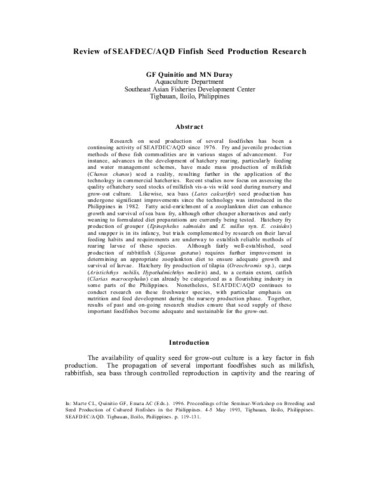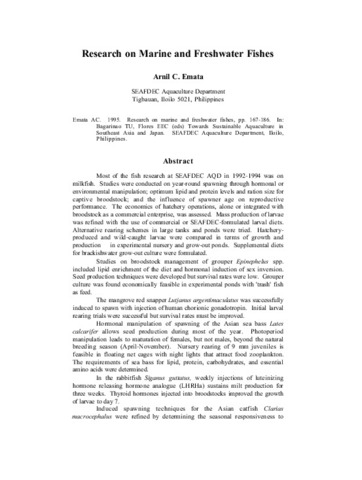Incidence and causes of mass fish kill in a shallow tropical eutrophic lake (Laguna de Bay, Philippines)
- Global styles
- MLA
- Vancouver
- Elsevier - Harvard
- APA
- Help

View/
Date
2001Author
Page views
10,963ASFA keyword
AGROVOC keyword
Taxonomic term
Geographic names
Metadata
Show full item record
Share
Abstract
Mass fish kills in Laguna de Bay, the largest lake in the Philippines, has been reported as early as in the 1930’s. With the introduction of and development of aquaculture in this lake, considerable attention and concern was focused on the problem. Records of mass fish kill in the lake mainly from unpublished sources and reports from fisherfolk were reviewed and the causes categorized. The data covered the period 1972 to 1998. Among the commercially important fish species affected were milkfish (Chanos chanos), Nile tilapia (Oreochromis niloticus), bighead carp (Aristichthys nobilis), snakehead (Channa striata), catfish (Clarias macrocephalus and C. batrachus, Arius manilensis), silver perch (Terapon plumbeus) and goby (Glossogobius giurus). The first three species are widely used in aquaculture and the rest are important in open water fishery. Sixty percent of mass fish kill incidents were due to low dissolved oxygen with more than half of these cases associated with blue-green phytoplankton blooms. Fish kills due to pollution from agriculture and industries, fish pathogens and other causes are also discussed. The incidence of mass fish kill reached its peak between 1977 to 1986. Records show that the most number of fish kills (80%) occurred between the months of May to September. The lakeshore towns in the central arm of the lake had the highest incidence of fish kill reported with 46% and followed by the west arm of the lake with 38% of all fish kills recorded.
Subjects
Fish kills--ResearchSuggested Citation
Cuvin-Aralar, M. L., Santiago, A. E., Gonzal, A. C., Santiago, C. B., Romana-Eguia, M. R., Baldia, S. F., & Palisoc Jr., F. (2001). Incidence and causes of mass fish kill in a shallow tropical eutrophic lake (Laguna de Bay, Philippines). In 9th International Conference on the Conservation and Management of Lakes. Conference proceedings (pp. 233–236). Shiga, Japan: Shiga Prefectural Government.
Type
Conference paperCollections
- Conference Proceedings [299]
Related items
Showing items related by title, author, creator and subject.
-
Review of SEAFDEC/AQD finfish seed production research
Quinitio, G. F.; Duray, M. N. (Aquaculture Department, Southeast Asian Fisheries Development Center, 1996)Research on seed production of several foodfishes has been a continuing activity of SEAFDEC/AQD since 1976. Fry and juvenile production methods of these fish commodities are in various stages of advancement. For instance, ... -
Status of development and use of alternative ingredients in aquaculture feed formulations in Singapore
Yihang, Ong; Ong, Vincent (Aquaculture Department, Southeast Asian Fisheries Development Center, 2015)The aquaculture industry in Singapore started in 1980s. The country has approximately 130 aquaculture farms, mostly located in the western part of the country. Aquaculture production mainly comes from coastal farms and the ... -
Research on marine and freshwater fishes
Emata, Arnil C. (Aquaculture Department, Southeast Asian Fisheries Development Center, 1995)Most of the fish research at SEAFDEC AQD in 1992-1994 was on milkfish. Studies were conducted on year-round spawning through hormonal or environmental manipulation; optimum lipid and protein levels and ration size for ...







